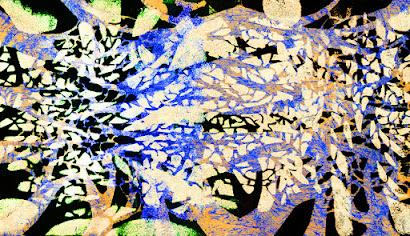1.
Dry rubbings!
What tools can we use? Let's not stop with crayons!
What papers can we use? Thin papers are favorites because (1) rubbings are easier to make on them; and (2) they're the easiest to use as overlays or backgrounds on the pages of art journals.
Many dry media will work for dry rubbing, but I usually opt for a water-resistant or waterproof medium -- china marker, oil pastel crayon, regular crayon, Shiva Stick, color pencil, charcoal, graphite pencil, etc. -- because after the rubbing is finished, a waterproof or water-resistant medium will allow me to come back in with a wet medium like acrylic ink, Golden High Flow acrylics, watercolor, etc.
Sara Sissenwein Norris recently threw a surprise party for my eyes when she used 9" x 12" Clustered Leaves and other StencilGirl stencils in making these rubbings:
Above: Sara did this crayon rubbing on Japanese calligraphy practice paper. Her crayon rubbing below was done on deli paper --
Sara also used white tissue paper in experimenting with rubbings. It's challenging to find tissue strong enough for this technique. In future, Sara may use dollar store white tissue or Lineco tissue paper; the latter is available from bookbinding suppliers, Amazon and other vendors. I see that it comes "buffered" as well as "unbuffered," so before I buy my next batch, I'll be looking up the difference! I bought some years ago but have no idea which version it was.
Using one of the nine stencils included in the 9" x 12" ATC Mixup Swatton #2, I made the rubbing below with a reddish Art Bar crayon and textured off-white (creamy) paper. This Artist Trading Card-sized stencil, Sprigs, is similar to, but not identical with, my 6" x 6" Sprigs.
For the next rubbing, also made with the ATC-sized Sprigs, I used gold foil paper and a black crayon --
2.
I made a short video -- here -- that starts with the history of dry rubbings, as I understand it; then it segues into showing how to make "rubbings" solely with wet media. It's worth a watch!
3.
Coming up below: Today's third and last segment covers several approaches to mixing wet media with dry media in making rubbings.
My 9" x 12" Blooming Where Planted mask looks like this ....
... and I decided to try using this mask to make more dry rubbings, using mineral paper.
Mineral paper comes in tablets like the one shown above; it comes in three sizes. If I remember correctly, it's made from calcium carbonate.
There were two reasons I wanted to try this paper -- (1) it's thin and translucent enough for a stencil to be placed under it for the technique of dry rubbing; (2) it accepts wet media without warping.
I did three quick tests.
For my first approach, starting with the photo below, I slid my mask under the paper --
Below: Next, I used a china marker (grease pencil) to do a dry rubbing across the top of the paper. I chose a china marker because I wanted a medium that would repel water.
Next, I sprinkled the dry rubbing with alcohol ink, then I tipped the paper to cause running:
Below: the paper after it had dried --
For another test to see what can happen with mineral paper, I pulled out watercolor pencils. This time, I wanted to use a dry medium that would be soluble in water. The photo below shows the dry rubbing created with these pencils.
The next step was to spray the surface with water. (I was to discover I'd used too much water!)
The photo above is a close-up of the final results, after the paper dried. Because I'd sprayed on more water than needed, the effect was a washed-out look.
(If you think I learned my lesson about a heavy trigger-finger on the water spray bottle, you would be guessing wrong!)
Above is the start of my last test on mineral paper. This time I used Art Bar crayons. These were the easiest to use for the dry rubbing technique since they can be laid completely sideways, reducing the number of strokes you need to make across the top of the paper.
The photo below shows my water spray bottle and my box of Brusho powdered pigments.
Next, I sprayed the surface with water -- again using too much!
While the surface was still wet, I sprinkled Brusho powders across it:
My close-up below shows the final result --
Of these three approaches to making dry rubbings on mineral paper, my favorite is this last one.
In testing the mineral paper, I used the pencil/crayon/marker on plain white paper before adding liquid media.
But rubbings can also be made on painted papers as long as the papers remain thin under a coat of acrylic paint.
A quick example: I grabbed paper previously printed with wet media, using Palm Fronds Silhouette Small (6" x 6") and Palm Fronds Silhouette Mini (4" x 4"); and I got out a new-to-me kind of grease pencil (see below), along with masking tape and my 9" x 12" Prayer Flags.
The Listo pencil's blue went well with the yellows and oranges of this paint-coated paper ....
Important note: Artist Sara Sissenwein Norris got the idea for making her prints from artist and teacher Carolyn Dube, here.
My sincere thanks to all who stopped here today! To scroll thru the pages of my StencilGirl stencils and masks, please start here. To follow this blog by email, please use that option in the upper right sidebar.
Stay safe and stay well!

















































